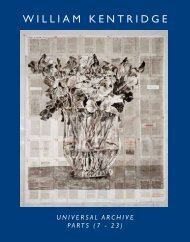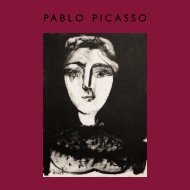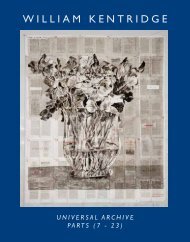Download PDF Catalogue - Annandale Galleries
Download PDF Catalogue - Annandale Galleries
Download PDF Catalogue - Annandale Galleries
Create successful ePaper yourself
Turn your PDF publications into a flip-book with our unique Google optimized e-Paper software.
By extension, the designs produced repetitively on the press using industrial inks must fall short of the full sacred patterns<br />
which imbue and enact the Law.<br />
The Printspace has been in continuous and productive operation ever since. It rivals any print studio in the major centres<br />
of the NT. It has produced over 600 editions of work which have not offended this principle. As an aside, this development<br />
is often lauded as a breakthrough by Yolngu into contemporary art although the technology which Gutenburg brought to<br />
Europe in the 1400s was already 4000 years old.<br />
It came as a surprise to some Yolngu friends when I asserted that I had heard Northeast Arnhemlanders described as The<br />
Murngin. They told me I was wrong and that this had never been their name. So I looked it up and found that N.B.Tindale’s<br />
Aboriginal Tribes of Australia (1974) had the following passage;<br />
“Murngin<br />
Term is not used to designate any grouping of tribes on the map. It is a general name applied by some western tribes in Arnhem<br />
Land to groups of people outside their area in northeastern Arnhem Land. The term was adopted first by Warner (1937) as a loose<br />
designation for some peoples sharing a specific form of kinship organization. According to Peterson (1969 MS) it has a general<br />
meaning of ‘shovel-nose-spear folk,’ and there is an implication that the people so named are aggressors. In tradition they came<br />
from the east. The classification of Northeastern Arnhem Land peoples preferred by aborigines is based on variations in the mode<br />
of speaking the pronoun ‘this.’ “<br />
The meaning of the word murrnginy described by the CDU Dictionary of Yolngu Matha is ‘spear--shovel-nose, iron and<br />
steel, people living in the east.’<br />
Since at least 1937 people of Northeast Arnhemland had been defined by others as a group who were able to source<br />
and handwork elements of iron and steel recovered from traders, shipwrecks and discards to create deadly spear blades.<br />
Quite clearly as at 1937 this was so prevalent as to be a definitional characteristic of Northeast Arnhemlanders.<br />
So it is traditional for Yolngu from the Miwatj to recover recycled industrially produced material to create new forms.<br />
Does this mean Gunybi’s Colourbond steel wall panel jigsawed on his lap into the Ngaymil pattern for the font of life is<br />
a traditional artwork? Or is the distinction meaningless unless to quarantine him from artists from the dominant culture?<br />
Will Stubbs April 2013<br />
27









